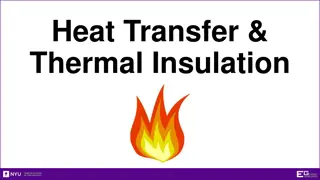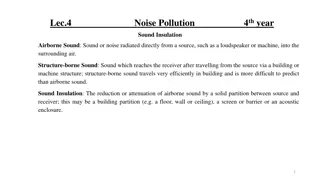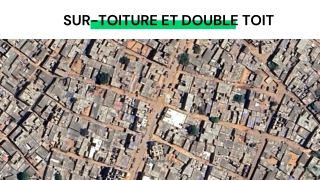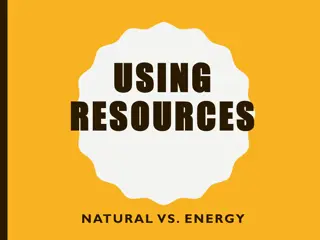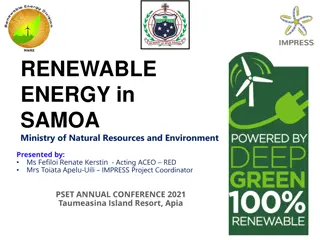Understanding Insulation and Energy Saving in Grade 7 Natural Sciences
Exploring the significance of insulating materials in energy conservation. Learn how various materials help in keeping cold items cold and hot items hot, along with the importance of insulation for heat transfer reduction. Discover the types of insulators, including those with air spaces like wool, cork, and feathers. See how styrofoam and ceiling insulation are utilized to minimize heat transfer, and understand the role of materials like wool in keeping us warm during cold weather.
Download Presentation

Please find below an Image/Link to download the presentation.
The content on the website is provided AS IS for your information and personal use only. It may not be sold, licensed, or shared on other websites without obtaining consent from the author. Download presentation by click this link. If you encounter any issues during the download, it is possible that the publisher has removed the file from their server.
E N D
Presentation Transcript
Natural Sciences Grade 7 Term 3: Energy and Change Insulation and energy saving
Topic 4 Insulation and energy saving Using insulating materials [part 1] Natural Sciences - Grade 7
Using insulating materials Using insulating materials Materials that are heat insulators: keep cold items cold; slow down heat transfer from the surroundings; keep hot items hot; slow down heat transfer from the hot item to the cooler surroundings; insulated window coverings [awnings; curtains; blinds; etc.]. In summer it is closed [minimize heat gain] to cool the house and block out the sun s radiation. In winter it is kept open to allow the sunlight through the house. Natural Sciences - Grade 7
Types of insulators Materials that contain air spaces, are the best insulators. Examples: - thatched roof [air is trapped in the spaces between the grass of the thatch] - wool - cork - straw - feathers - grass - styrofoam Natural Sciences - Grade 7
Insulators are used to reduce heat transfer Insulators are used to reduce heat transfer Styrofoam It is made from polystyrene [a type of plastic; plastic is a poor conductor of heat]. It is also used to make food packaging [picnics; take-away meals; hot coffee; etc.]. The food in styrofoam boxes can be kept warm / hot. Natural Sciences - Grade 7
Insulators are used to reduce heat transfer Insulators are used to reduce heat transfer Ceiling insulation It minimizes heat gain during summer. It minimizes loss of heat during winter. It is mostly made from fibreglass strands [air is a poor heat conductor and it becomes trapped between the fibreglass strands ; the amount of heat loss/gain is limited; stops conduction and convection from taking place]. Foam can be sprayed in the roof structure above the ceilings. Blanket insulation can be rolled out above the ceilings. Natural Sciences - Grade 7
Insulators are used to reduce heat transfer Insulators are used to reduce heat transfer Materials that keep us warm Woollen clothing prevents the body heat from escaping, e.g. jerseys; woollen hats; gloves; jackets; etc. Bedding, e.g. blankets; duvets; comforters; etc. It keeps people warm when it is cold. The air is trapped between the fibres and therefore extra insulation is given. Thermal jackets worn by Russian, Eskimo and Norwegian people keep them warm in temperatures that are below 0 C. Natural Sciences - Grade 7
Insulators are used to reduce heat transfer Insulators are used to reduce heat transfer Insulating vacuum flasks and cool boxes Insulating materials such as plastic and styrofoam are used to make cooler boxes [foam / sponge materials are excellent insulators. They have many air bubbles in the foam. Air is an excellent insulator. Liquids are kept hot or cold in vacuum flasks. Between the flask and the casing is a vacuum, meaning no air particles. Natural Sciences - Grade 7
Insulators are used to reduce heat transfer Insulators are used to reduce heat transfer Water pipes - Cover water pipes with an insulating material to: prevent water from freezing and water pipes from bursting as well as preventing water waste. prevent loss of heat through the metal pipes and reduce electricity waste. - Water pipes are made from plastic materials [PVC]. Doors Fill the gaps of fitted doors with foam rubber [weather strips] to prevent warm air from escaping. Walls Build outer walls with a double layer of bricks [cavity walls - air space reduces heat transfer]. . Natural Sciences - Grade 7
Insulators are used to reduce heat transfer Insulators are used to reduce heat transfer Traditional / Indigenous homes Roofs and some walls are made of grass which is a good natural insulator. The framework is smeared with mud. Floors are made from cow dung [dries and form a hard, waterproof floor and it is heat insulating]. Rondavels are build with thatched grass roofs [Xhosa]; beehive huts [Zulu]. Natural Sciences - Grade 7

























